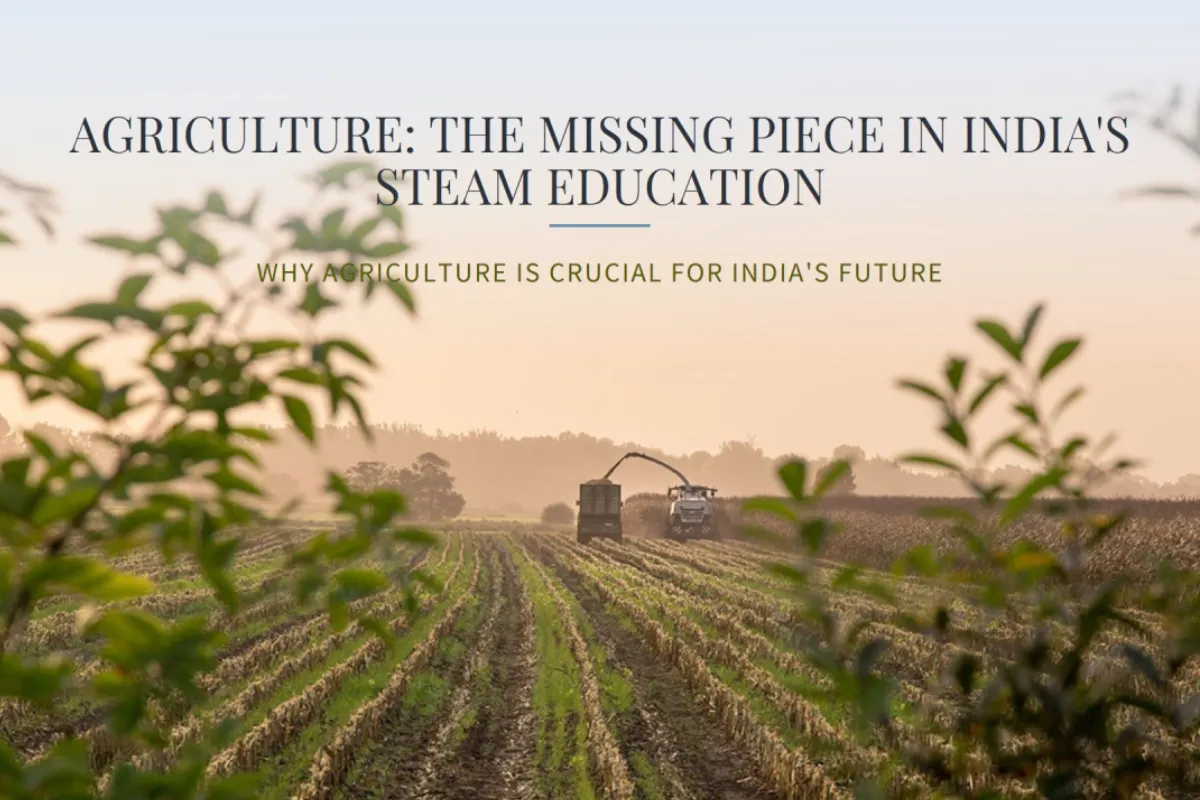The global shift from STEM (Science, Technology, Engineering, and Mathematics) to STEAM, which adds the Arts into the educational mix, is being celebrated as a step forward in fostering creativity and innovation. However, in the Indian context, the need to prioritize Agriculture within this framework is urgent. A more impactful approach for India would be the adoption of STEAAM, where Agriculture stands as the “BIG A,” emphasizing its essential role in the economy and rural livelihood.
Agriculture: The Backbone of India’s Economy
Agriculture continues to be a critical component of India’s economy, employing over 40% of the population and contributing approximately 18% of the country’s GDP. Despite rapid industrialization, the agrarian sector faces persistent challenges: climate change, water scarcity, outdated techniques, and shrinking landholdings.
India’s National Education Policy (NEP) 2020 advocates for interdisciplinary learning, presenting a perfect opportunity to integrate Agriculture into the STEM curriculum, making it STEAAM. This approach is vital for equipping students with the knowledge and skills necessary to revolutionize India’s agricultural practices, address food security issues, and tackle rural unemployment.
The “BIG A” in STEAAM: Why Agriculture Deserves Special Focus
India’s unique socio-economic landscape demands that Agriculture be treated as a core discipline. As the “BIG A” in STEAAM, Agriculture’s integration into the curriculum can help students better understand the challenges of modern farming, water management, and sustainable land use.
The introduction of AgriTech solutions, such as precision farming, drone technology, and AI-based crop management, has shown immense potential for transforming the sector. By focusing on Agriculture in STEM education, India can develop a workforce equipped to modernize farming practices and drive rural development.
Aligning STEAAM with Global and National Priorities
Globally, agriculture is at the forefront of addressing critical issues such as food security and climate change, both of which are core elements of the United Nations’ Sustainable Development Goals (SDGs). Specifically, SDG 2 (Zero Hunger) and SDG 13 (Climate Action) highlight the importance of sustainable agricultural practices. In this context, adopting STEAAM can ensure that Indian students are not only equipped to tackle domestic agricultural challenges but also contribute to global solutions.
Additionally, the Indian government’s programs like Atmanirbhar Bharat (Self-Reliant India) and Pradhan Mantri Krishi Sinchayee Yojana (PMKSY) emphasize the need for sustainable farming and rural development. By integrating Agriculture into STEM education, India can align its educational framework with these national goals, fostering a generation of agricultural technologists, scientists, and innovators.
Industry Demand: AgriTech and Employment
The AgriTech sector in India is experiencing rapid growth, with industry experts predicting a market size of $24.1 billion by 2025. This growth offers immense potential for job creation, especially in rural areas where agriculture is the primary source of livelihood. STEAAM can play an important role in equipping students with the technical skills required to capitalize on these opportunities.
By integrating Agriculture into the educational system, India can create a more skilled workforce capable of driving innovation in farming practices, supply chain logistics, and sustainable land management. This, in turn, will help address rural unemployment and reduce rural-to-urban migration by creating more employment opportunities in the agricultural sector.
Arts in STEAAM: Complementary, Not Competing
While the focus of STEAAM is on Agriculture, the inclusion of the Arts should not be overlooked. The Arts play a crucial role in fostering creativity, design thinking, and problem-solving. In the context of Agriculture, the Arts can contribute to sustainable farming practices, rural design, and innovative marketing strategies for agricultural products. Integrating the Arts into STEAAM allows for a more holistic approach to solving agricultural challenges, encouraging both scientific innovation and creative thinking.
For example, visual arts can be used to develop eco-friendly packaging for rural products, while design thinking can help in creating efficient irrigation systems. The combination of Agriculture and the Arts within STEAAM ensures that students not only gain technical expertise but also develop the creative skills necessary to address the complex challenges of modern agriculture.
The Case for STEAAM in India
As an educationist deeply committed to both education and rural empowerment, I believe STEAAM, with Agriculture as the “BIG A,” is a more relevant and impactful educational model for India. While the inclusion of the Arts is essential for fostering creativity, the critical challenges facing India’s agrarian economy require an educational focus that prioritizes agricultural science and technology.
By adopting STEAAM, India can create an education system that not only prepares students for global challenges but also equips them to drive innovation in agriculture, contributing to rural development, food security, and climate resilience.
A Call to Action
India’s educational institutions, policymakers, and industry leaders must collaborate to adopt the STEAAM framework across all levels—from schools to universities and research institutions. This integration will help build a future-ready workforce that is equipped to address both local and global agricultural challenges, fostering sustainable development and rural empowerment.
The shift to STEAAM is not just an educational reform; it is a strategic imperative for India’s future. By embracing this model, we ensure that our students are prepared to tackle the evolving challenges of the 21st century with both creativity and practical skills, contributing to a self-reliant, empowered, and sustainable India.
Contributed By: Kunwar Shekhar Vijendra, Co-founder & Chancellor, Shobhit University | Chairman, ASSOCHAM National Council on Education
Keep watching our YouTube Channel ‘DNP INDIA’. Also, please subscribe and follow us on FACEBOOK, INSTAGRAM, and TWITTER.
